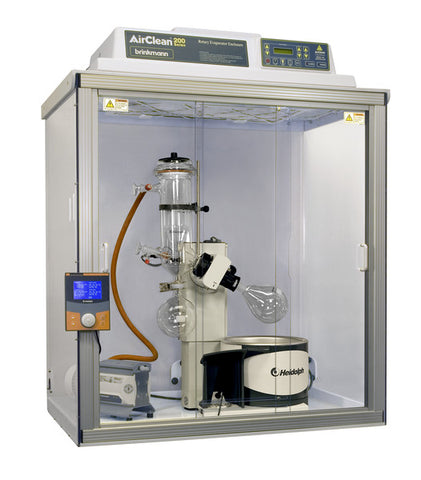Vacuum is an important component of a rotary evaporation system (see our previous post on the subject). During usage, it is equally important to make sure your system works well and "holds vacuum" - in other words, that it maintains the pressure and does not leak outside air into the system. There are several reasons why a system might not hold vacuum.

A complete Heidolph benchtop rotary evaporation system with vacuum pump and cold trap condenser in a standalone AirClean® enclosure.
If you are seeing or expecting problems, you should first check if the system will hold vacuum when there is no liquid in it. Theoretically, this should be a closed system with no means of producing additional gas through evaporation. If the system is closed and the pump is working properly, it should achieve the pump's maximum vacuum / minimum pressure relatively rapidly. (If it does, you can skip the next two paragraphs.)
If it does not, check the integrity of the pump. You can disconnect your pump and use a vacuum gauge directly on the pump, with a closed line at the end, to see how well it still works. If there is no possibility for air to be added to the system (through leaky joints or connections, for example), the vacuum pump should be able to rapidly achieve its maximum vacuum / minimum pressure.
Next, check your system for leaks. Leaks usually occur at joints, but may also occur due to cracked or otherwise damaged glassware or other parts. Leaks may also occur at the seals where your condenser connects with the body of the rotary evaporator near the upper end of the vapor tube. Sometimes you can listen for leaks by placing your ear near glass joints and connections, but many times the vacuum pump is loud enough that small leaks may not be detectable this way. Remove and reconnect all joints and connections. If necessary, you can remove and replace each item one at a time, testing after each connection by stoppering or otherwise blocking open upstream joints to try to identify a faulty connection or item piece-by-piece.
If the pump is in good working order and you cannot find any leaks but your system is still not holding a consistent vacuum during evaporation, check the conditions under which you evaporate your solvents. The transformation of a liquid into a gas involves a very large increase in volume. At standard temperature and pressure 1 mole gas = 22.4 L. Meaning, for example, that 18 mL of H2O (1 mole) converts into 22.4 l of gas. The same is true for 104 mL of diethyl ether, 64 mL dichloromethane, and 132 mL of hexane. However, at lower pressures, an small amount of liquid becomes a far larger volume of gas. For instance, at one tenth of standard atmospheric pressure (0.1 atm, or 101 mbar), that same 18 mL of water would turn into approximately 224 liters of gas. This due to Boyle's Law, which states the pressure of a gas is inversely proportional to its volume. Less pressure mean more volume, and many rotary evaporator applications operate at very low pressures.
The rate at which gas is being produced due to evaporation is important because all vacuum pumps have a maximum volume of gas they can remove per unit of time. This means that if you evaporate liquid at a high enough rate you can produce more gas than your pump can remove. More gas in the system increases the pressure. If this is the case you should see the pressure decrease towards the end of your evaporation process as the gas produced decreases and eventually stops. If your system shows signs that the pump is not keeping up, you have two options: you can either deal with the process being slower than it otherwise would be due to lower than optimum evaporation rates, or you can get a stronger pump.
Note that pumps clearance rates usually decrease as their minimum pressure is approached. So, for instance, the VP18R vacuum pump is rated to clear 18 L / min and has a minimum pressure of 20 mbar. However, it will not clear 20 L / min of gas when the pressure is at or near 20 mbar. You should be able to obtain these pump curves, either from Laboratory Supply Network or from the manufacturer, upon request.

A sample vacuum pump curve showing hypothetical flow rates vs. pressure for two different pumps.
Vacuum is an integral component in a rotary evaporation process. Being able to rapidly and effectively identify any pressure-related problems will help you run a more efficient process and minimize your downtime.
